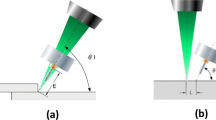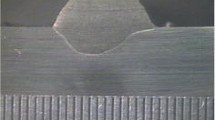Abstract
The finite element method (FEM) and neural network were applied for predicting the bead shape in laser spot welding of type 304 thin stainless steel sheets. The parameters of pulsed Nd:YAG laser spot welding such as pulse energy, pulse duration, sheet metal thickness, and gap between sheets were varied for various experiments and numerical simulations. The penetration depth and nugget size of spot welds measured for specimens without gap were compared with the calculated results to verify the proposed finite element model. Sheet metal thickness, gap size, and bead shape of the workpiece without gap were selected as the input variables for the back-propagation learning algorithm of the neural network, while the bead shape of the workpiece with and without gap was considered as its output variable. Various combinations of stainless steel sheet metal thickness were considered to calculate the laser-spot-weld bead shape of the workpiece without gap, which was then used as the input variable of neural network to predict the bead shape for various gap sizes. This combined model of finite element analysis and neural network could be effectively applied for the prediction of bead shapes of laser spot welds, because the numerical analysis of laser spot welding for the workpiece with gap between two sheets is highly limited.
Similar content being viewed by others
Abbreviations
- C(T) :
-
temperature-dependent specific heat capacity (J kg−1 K−1)
- ρ(T) :
-
temperature-dependent density (kg m−3)
- K(t) :
-
temperature-dependent thermal conductivity (W m−1 K−1)
- Q :
-
power generation per unit volume in the domain (W m−3)
- F :
-
focusing number
- H :
-
beam intensity (W m−2)
- M :
-
beam quality number
- k n :
-
thermal conductivity normal to surfaces that are subject to radiation, convection, and imposed heat fluxes (W m−1 K−1)
- h :
-
heat transfer coefficient for convection (W m−2 K−1)
- σ :
-
Stefan-Boltzmann constant for radiation (W m−2 K−4)
- ɛ :
-
emissivity
- T 0 :
-
ambient temperature (K)
- q :
-
heat flux (W m−2)
- P h :
-
peak power of initial pulse spike (W)
- P l :
-
lowered average power (W)
- t s :
-
initial pulse spike duration (s)
- t p :
-
total pulse duration (s)
- d :
-
vaporization depth (m)
- C s :
-
solid specific heat capacity (J kg−1 K−1)
- C L :
-
liquid specific heat capacity (J kg−1 K−1)
- T m :
-
melting point (K)
- T v :
-
boiling point (K)
- L f :
-
latent heat of fusion (kJ kg−1)
- L v :
-
latent heat of vaporization (kJ kg−1)
References
J. Mazumder and D. Voekel: Proc. LAMP ’92, Japan High Temperature Society, Osaka, Japan, 1992, pp. 373–80.
H.E. Cline and T.R. Anthony: J. Appl. Phys., 1977, vol. 48, pp. 3895–3900.
D.C. Weckman, L.C. Mallory, and H.W. Kerr: Z. Metallkd., 1989, vol. 80, pp. 459–68.
J. Mazumder and W.M. Steen: J. Appl. Phys., 1980, vol. 51, pp. 941–47.
O.O.D. Neto and C.A.S. Lima: J. Phys. D: Appl. Phys., 1994, vol. 27, pp. 1785–1804.
M.R. Frewin and D.A. Scott: Welding J., 1999, vol. 1, pp. 15s-22s.
J.T. Liu, D.C. Weckman, and H.W. Kerr: Metall. Trans. B, 1993, vol. 24B, pp. 1065–76.
H.N. Bransch, D.C. Weckman, and H.W. Kerr: Welding J., 1994, vol. 73, pp. 141s-151s.
C. Dawes: Laser Welding, Abington Publishing, Cambridge, United Kingdom, 1992, pp. 31–53.
J. Wilson and J.F.B. Hawkes: Lasers: Principles and Applications, Prentice-Hall International(UK) Ltd., Hertfordshire, United Kingdom, 1987, pp. 166–89.
W.M. Steen: Laser Material Processing, Springer-Verlag, Berlin, 1991, pp. 108–44.
Y. Matsuhiro, Y. Inaba, and T. Ohji: Jpn. Welding Soc., 1993, vol. 11, pp. 479–83.
C. Lampa, A. Kaplan, J. Powell, and C. Magnusson: J. Phys. D: Appl. Phys., 1997, vol. 30, pp. 1293–99.
P. Tekriwal and J. Mazumder: Welding J., 1988, vol. 67, pp. 150s-156s.
A. Kaplan: J. Phys. D: Appl. Phys., 1994, vol. 27, pp. 1805–14.
S.C. Chapra and R.P. Canale: Numerical Method for Engineers, 2nd ed., McGraw-Hill Book Co., New York, NY, 1988, pp. 358–61.
M.R. Frewin and D.A. Scott: Proc. ICALEO ’95, Laser Institute of America, Orlando, FL, 1995, pp. 904–13.
Author information
Authors and Affiliations
Rights and permissions
About this article
Cite this article
Chang, W.S., Na, S.J. Prediction of laser-spot-weld shape by numerical analysis and neural network. Metall Mater Trans B 32, 723–731 (2001). https://doi.org/10.1007/s11663-001-0126-3
Received:
Issue Date:
DOI: https://doi.org/10.1007/s11663-001-0126-3




